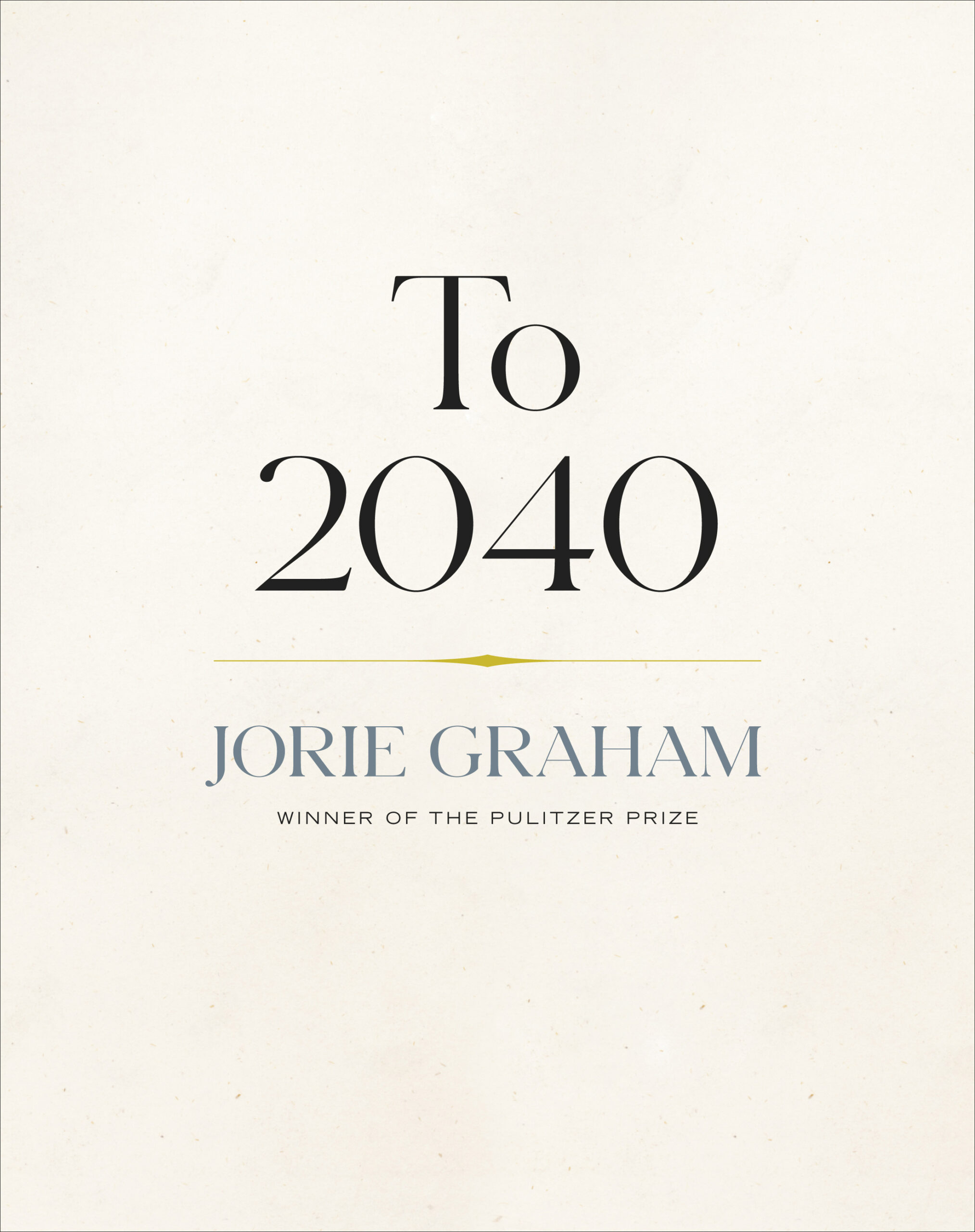WASHINGTON (THE WASHINGTON POST) – When I first met Jorie Graham around 1980, at a literary party somewhere in the Village, she was a film student at New York University, where, passing a lecture hall on campus one day, she heard words that had changed her life. Slipping into the back of the lecture hall, she discovered, listening to the critic ML Rosenthal, that she had heard the final line of TS Eliot’s “The Love Song of J Alfred Prufrock”: “Till human voices wake us, and we drown.” At that moment, she knew herself a poet.
This sounded not so much like the lightning bolt of Rilke’s clarion call (“You must change your life”) but rather recognition of a new language, beyond the three she already had (French, Italian, English). This was the poet’s tongue, overheard in its vocal intensity. If this was a soul awakening, it was eerily prophetic: the sound of a human voice waking a poet to a lifelong immersion in poetry.
This seemingly hyper-romantic flash was real, unlike the assorted apocrypha of Graham’s life, little myths that have shadowed her since her debut on the poetry scene, with rumours that she was an Italian countess, despite her having been born in New York, to a mother and father from Brooklyn and West Virginia, respectively.
In the summer of 1981, I travelled to Italy on a Guggenheim fellowship. A colleague at Columbia, where I was teaching, found me a lovely rental in a tiny town outside of Florence, and Jorie invited me to ride down with a family friend to Umbria to visit her at the beautiful home her mother, the renowned sculptor Beverly Pepper, had rebuilt from a 12th-century fortification, the property ringed with her towering, sentinel-like sculptures. They stood by as we talked poetry into the night.
Now we have “To 2040” (Copper Canyon), Graham’s 15th collection, to add to her astounding oeuvre – a culmination of what our late mutual friend Mark Strand often observed: that Graham writes “big poems.”
The poems are elegiac, and once again her followers may read this as personal elegy – which is only hinted at. (In 2021, Graham received a diagnosis of a rare form of uterine cancer.) What is “big” about the poems is that they (once again) take on a world that may be breathing its last, which is where “To 2040” begins. “Are we extinct yet?” she asks at the outset.
Graham offers her writing hand, held out like Keats’s, in his famous fragment that she echoes as both continued warning and gesture of lost hope. (In a darker reenactment, she grasps, in the shower, “a clawful” of seemingly chemo-loosened hair.)
Despite the sizable ambition of her poems – and “To 2040” may be her most ambitious collection, if an all-permeating sense of despair may be characterised as ambitious – they require the reader to look closely with her point of view, to observe and finally see the particularity of loss in an age of non-attention, sounding an alarm, a plain, plangent SOS side by side with erudition, focused less on the enormity than the small corporeality of birdsong, of a worm in the earth, of rain on a bare scalp.
If poetry is an art made of consciousness, then in all her books Graham’s is the voice of the shape-shifting conscious mind, of perception itself. The autobiographical, when it is introduced as narrative, seems less compelling than a leaf in wind – as everything in her oeuvre finally comes apart and coalesces at the level of atoms: “It’s not a reasonable place, this continuum between us, and yet here again I put the olive trees in,” she writes in an earlier poem, “I’m Reading Your Mind.”
“To 2040,” titled after the year in which temperatures are projected to rise 1.5 degrees Celsius above pre-industrial levels, arrives amid global doom. But the final coda-poem, “Then the Rain,” conjures up a fever dream of unlikely human and planetary survival, retelling ongoing and future horror but also hinting at redemption in the end:
out of the touching of one atom by another,
out of the accident of touch,
the rain came.

If there is a consistent recurring observation in the decades of critical response to Graham’s poems, it’s her cerebral speed – wonder at the “quicksilver” velocity at which her insights travel toward and hit the page. These observations form a chorus – “vertiginous,” “hurtling forward,” “shifting gears at such speed,” “Whitmanic gusts,” “riptides.” “To 2040” too seems swept up in this surge.
But while the undeniable appearance of a spinning wind of imagery and thought-leap is familiar, I have always read this acceleration as an illusion. In actuality, it’s a very slow whirlwind, with the author at the “eye.” Insights are plentiful, but they are purposely and painstakingly orchestrated for the reader to view the suspension of phenomena – the stop-time centre not holding – while displaying what is being lost down to Blake’s grain of sand. Again, a plea for attention to the intimate details of ongoing and coming “ecocide.” This stylistic strategy of de-acceleration opens up the senses of the reader to breathe in the ongoing extinction that hovers over us all.
The themes of her new book have haunted her since her ninth collection, “Never,” when she noted in an interview that Darwin, finishing “On the Origin of Species,” believed that the rate of extinction for species had been one in every five years. Today the rate of extinction is estimated as one every nine minutes. What will it be in 2040? Darwin’s “one in five” plucked from the current orgiastic species slaughter is a cinematic double vision – a camera trick that records both nano and macro simultaneously.
There is the obsessive search for a vessel, a form that will hold a filmic/poetic future, in all of Graham’s work. In her 1999 book “Swarm,” she is “keeping the parts from finding the whole again.” Before her 2005 book “Overlord” and 2008’s “Sea Change,” where her environmental and political concerns coalesced, there were the philosophical poetic meditations on culture – books about painting, about the relation of the body and spirit. Yet each collection mirrored Pound’s “sprezzatura”: effortless grace, the rippling silver-backed leaves of olive trees; rhythms of the thinking mind. “Grief is a form that can shape this,” she reminds us in “To 2040,” where grief is the very texture of the shapes – one unsustainable loss after another.
Jorie and I became pregnant at around the same time, in 1982, and talked about raising our daughters and about the “maternal gaze.” She described her first memories of her mother “looking away” but felt this interrupted gaze was justified by the profound distraction of her mother’s art.
In “To 2040,” the once-imagined maternal gaze of nature has turned away from the evolutionary experiment that was humanity.
Before 2040, the birds of earth die out and become one of the last hopeless “lab” simulations – (“do they not satisfy/us?”)
These wired, fake-feathered creatures are engineered to look like “those not coming back,” though they sing and flock under the “strange sun.”
In one of the most alarming, surreal details of this poem, these synthetic birds are stalked by future “humans” – who laugh and chase the invented creatures – till they “disappear.” These unfeeling humans are the future, and they are the “now” and “us” – passive, indifferent to world annihilation, self-obsessed, laughing as we chase down our own deaths.
In “To 2040,” the “real” world is remembered, unsaved even as it is desperately reinvented, even in technology’s reproductions, even as a human voice wakes us from a once-dream that is moving, then stilled.
From “Dusk in Drought”:
A brief shower coalesces but,
as always, passes.
A fly is rubbing its,
head with its wings, in the dark.
The disappearing watertable,
is not entirely,
silent if I am completely, still.
Listen: I am, completely still. – CAROL MUSKE-DUKES





